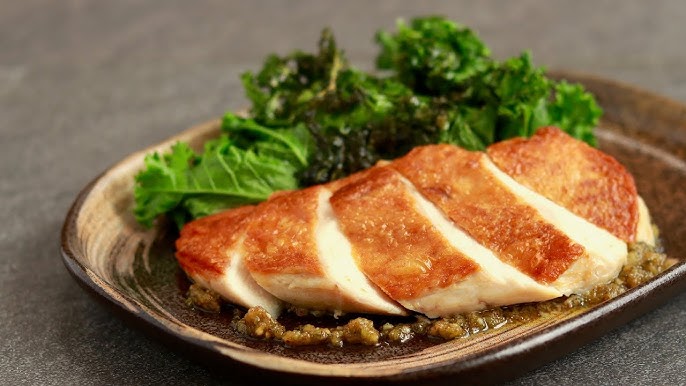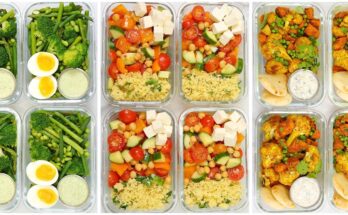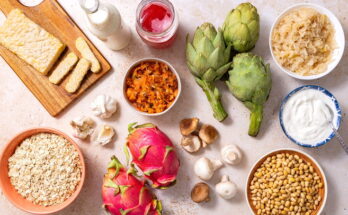Sous Vide Chicken Breast Recipe: Sous vide (pronounced “soo-veed”) is a French term meaning “under vacuum.” It refers to the method of cooking food slowly in a water bath at a precisely controlled, low temperature. Unlike traditional methods that cook food at high heat for shorter times, sous vide gently cooks food evenly throughout, resulting in incredible texture, juiciness, and flavor. The magic of sous vide lies in its precision. You place food—typically sealed in a vacuum-sealed bag—into a hot water bath held at the exact temperature you want the final cooked food to reach. That means no more overcooked chicken or dry meat!
This method has long been a favorite in high-end restaurants for its consistency, and thanks to the rise of affordable sous vide cookers for home kitchens, now anyone can cook like a pro. Chicken breast, in particular, benefits immensely from sous vide cooking. It’s easy to dry out with traditional methods, but sous vide ensures it stays juicy and tender.
Why Use Sous Vide for Chicken Breast?
Chicken breast is lean, making it notoriously tricky to get just right. Cook it too long, and it’s dry and stringy. Not enough, and it’s unsafe. Enter sous vide. Cooking chicken sous vide gives you:
- Perfect doneness – every single time.
- Juicy, moist texture that’s never rubbery or dry.
- Flexibility – you won’t overcook your chicken even if you leave it a bit longer.
- Enhanced flavor – marinades and seasonings stay locked in.
Plus, sous vide cooking is incredibly hands-off. Once the chicken is sealed and in the bath, you’re free to prep sides, clean the kitchen, or relax.
Ingredients You’ll Need
Essential Ingredients
Here’s what you’ll need to make a simple, flavorful sous vide chicken breast:
- Boneless, skinless chicken breasts – Fresh is best, but you can use frozen if vacuum-sealed.
- Kosher salt – Helps season the meat throughout.
- Freshly ground black pepper – For depth and balance.
- Olive oil or butter – A small amount adds richness and helps during searing.
- Garlic (optional) – Fresh or granulated adds an aromatic kick.
- Fresh herbs – Such as thyme, rosemary, or parsley for earthy flavor.
The ingredient list is minimal, but that’s the beauty of sous vide—it brings out the best in simple, quality ingredients.
Optional Flavor Enhancers
Want to take your chicken up a notch? Here are some flavor enhancers you can experiment with:
- Citrus slices – Lemon or orange slices add bright, zesty notes.
- Paprika or smoked paprika – Adds color and a subtle smoky flavor.
- Chili flakes – For a spicy kick.
- Mustard or Dijon – A thin coat inside the bag brings tang and complexity.
- Honey or maple syrup – Adds a light sweetness and helps with caramelization during searing.
Sous vide cooking is very forgiving, so feel free to try different herbs, spices, or even marinades to suit your taste.
Equipment You’ll Need for Sous Vide Cooking
Sous Vide Precision Cooker
This is the star of the show. A sous vide immersion circulator maintains the water bath at an exact temperature. Popular brands include Anova, Breville Joule, and Inkbird. Choose one with an easy-to-read display and app connectivity if you want extra convenience.
Look for features like:
- Accurate temperature control (±0.1°F)
- Powerful circulation for even heating
- Timer function for hands-off cooking
Vacuum Sealer or Ziplock Bags
For best results, use a vacuum sealer to remove air and ensure the chicken stays fully submerged. However, a ziplock bag works just fine using the water displacement method. Here’s how:
- Place the seasoned chicken in the bag.
- Slowly lower the bag into the water bath, letting the water pressure push the air out.
- Seal the bag just before it’s fully submerged.
Other Helpful Tools
- Large pot or container – A deep vessel to hold your water bath.
- Tongs – For safely removing the hot bag from the water.
- Cast iron skillet or grill pan – For that final sear to add texture and color.
- Thermometer (optional) – To double-check doneness if desired.
With this setup, you’re fully equipped to create restaurant-worthy chicken at home.
Preparing the Chicken Breast for Sous Vide
Trimming and Cleaning the Chicken
Before sealing the chicken in your bag, make sure it’s clean and properly trimmed. Remove any excess fat or connective tissue, especially the white tendon running along the side. A clean, trimmed breast ensures even cooking and a better mouthfeel.
Pat the chicken dry with paper towels to help seasoning stick. If your chicken has been previously frozen, make sure it’s completely thawed (unless you’re adjusting cooking time for frozen meat).
Seasoning Tips
A well-seasoned chicken breast makes all the difference. Keep it simple or get creative, but don’t skip this step. Here’s a basic seasoning approach:
- Salt and pepper generously on both sides.
- Add olive oil or butter for extra moisture and flavor.
- Place herbs or garlic cloves on top before sealing.
Don’t go overboard—remember that sous vide locks in flavor. A little goes a long way.
Marinating vs Dry Rubs
Both methods work well for sous vide:
- Marinades are great for infusing flavors into the meat, especially acidic ones like lemon, vinegar, or yogurt-based.
- Dry rubs stick well and won’t make the bag watery, preserving the meat’s texture.
If marinating, do it for 30 minutes to 2 hours max, especially with acidic ingredients, or you risk a mushy texture.
Step-by-Step Guide to Cooking Sous Vide Chicken Breast
Step 1: Preheat Your Sous Vide Water Bath
Start by filling your sous vide container or pot with water and set your immersion circulator to the desired temperature. For juicy, tender chicken, set it to 145°F (63°C) — this gives you perfectly cooked meat with a soft, moist texture. If you prefer a firmer, more traditional feel, go for 150°F (66°C). Let the water reach the target temperature before adding your chicken to ensure consistent cooking from the start.
Step 2: Seal the Chicken Properly
Season boneless, skinless chicken breasts generously with salt, pepper, and herbs like thyme, rosemary, or garlic powder. You can also add a drizzle of olive oil or butter for richness. Place each breast in a vacuum-seal bag or resealable freezer bag using the water displacement method: slowly lower the bag into the water, letting the pressure push out the air before sealing it shut. Removing air ensures even cooking and prevents the bag from floating.
Step 3: Cooking Temperature and Time Guide
Once your water bath is preheated, submerge the sealed chicken breasts completely. Clip the bag to the side of the container if needed to keep it from moving around. Cook for 1½ to 2 hours for optimal texture and flavor. The beauty of sous vide is its flexibility — you can leave it for an extra 30 minutes without overcooking. The chicken will emerge evenly cooked from edge to center, impossibly juicy, and ready for a finishing touch.
Step 4: Finishing with a Quick Sear
When the sous vide time is up, remove the chicken from the bag and pat it completely dry with paper towels. Heat a skillet or grill pan over high heat and add a tablespoon of oil or butter. Sear each side for about 30–45 seconds, just until golden brown. This quick sear adds flavor and texture — that crisp, caramelized crust complements the tender interior beautifully.
Step 5: Resting and Slicing
Let the chicken rest for 2–3 minutes after searing to allow the juices to redistribute. Slice against the grain into medallions and serve immediately. The result? Perfectly moist, flavorful chicken with no dryness or guesswork.
Sous vide chicken breast is restaurant-quality cooking made simple — tender, juicy, and foolproof every time. Serve it with roasted veggies, mashed potatoes, or toss it into a salad for a meal that’s effortlessly elegant.
Temperature and Time Chart for Perfect Doneness
Sous vide allows you to control your chicken’s texture like never before. Here’s a quick reference chart to help guide your preference:
| Temperature | Texture | Recommended Time |
|---|---|---|
| 130°F (54°C) | Extremely soft, slightly raw texture | 2 hours (not recommended for safety) |
| 135°F (57°C) | Ultra tender, very juicy | 1.5 to 4 hours |
| 140°F (60°C) | Perfectly juicy, tender | 1.5 to 4 hours |
| 145°F (63°C) | Slightly firm, juicy | 1.5 to 4 hours |
| 150°F (66°C) | More traditional texture | 1.5 to 4 hours |
Pro Tip: For meal prep, 140°F is the best balance—it gives you room to refrigerate, reheat, and still enjoy tender chicken.
Pro Tips for Juicy, Flavorful Chicken Every Time
Avoiding Common Mistakes
Even though sous vide is largely foolproof, here are some tips to keep your chicken perfect:
- Don’t skip the drying step before searing – moisture = no browning.
- Avoid overcrowding the water bath.
- Double seal your bags if using a vacuum sealer—especially for longer cooks.
- Keep water level consistent using a lid or ping pong balls to reduce evaporation.
- Don’t exceed 4 hours—chicken will become mushy.
Flavor Pairing Ideas
Want to mix it up? Try these easy seasoning combos:
- Lemon + thyme + garlic
- Cajun spice + paprika + chili flakes
- Basil pesto + Parmesan
- Soy sauce + ginger + sesame oil
- BBQ rub + honey drizzle
Sous vide chicken is versatile and adapts beautifully to any flavor profile.
Serving Suggestions and Pairings
Side Dishes That Complement Sous Vide Chicken
The beauty of sous vide chicken breast is its ability to shine as both a main dish and a versatile protein in a variety of meals. Here are some go-to sides that pair beautifully with your perfectly cooked chicken:
- Roasted Vegetables – Think carrots, zucchini, or Brussels sprouts tossed in olive oil and herbs.
- Garlic Mashed Potatoes – Creamy, buttery, and rich, a comforting classic.
- Steamed Rice or Quinoa – Light grains that soak up juices and sauces well.
- Garden Salad – Fresh greens with vinaigrette to balance the richness of the chicken.
- Grilled Asparagus or Broccolini – Adds a crunchy contrast to tender chicken.
For a lighter plate, pair with cauliflower mash or a zesty cucumber salad. And for a carb-loaded, satisfying meal, load up with mac and cheese or baked sweet potatoes.
Sauce Ideas for Extra Flavor
A sauce can turn your chicken from simple to sensational. Here are some favorites:
- Creamy Garlic Parmesan Sauce
- Lemon Butter Sauce
- Honey Mustard Glaze
- Spicy Sriracha Mayo
- Herb Chimichurri
Whether you’re meal prepping or serving dinner guests, a well-matched sauce can elevate your dish with very little effort.
Storing and Reheating Sous Vide Chicken
Refrigeration and Freezing Tips
Sous vide chicken is excellent for meal prep and storing for later use. Here’s how to keep it fresh:
- Refrigerator: Store cooked chicken in an airtight container or sealed bag for up to 4–5 days.
- Freezer: Vacuum-sealed chicken can last in the freezer for up to 3 months. Make sure to label it with the cook date and contents.
To freeze:
- Let chicken cool completely.
- Place in a vacuum-sealed or airtight freezer-safe bag.
- Lay flat in the freezer for easy stacking.
Best Reheating Methods Without Drying Out
Reheating sous vide chicken correctly preserves its juiciness:
- Best Method: Reheat sous vide-style! Set the water bath to 130°F and heat the chicken for 30–45 minutes (in its original sealed bag).
- Quick Method: Microwave gently with a splash of broth, covered with a damp paper towel.
- Pan Reheat: Sauté lightly with a bit of butter or oil until warmed through.
Avoid high heat or dry oven reheats—they can ruin that perfect texture you worked for.
Why Sous Vide is Perfect for Meal Prep
Batch Cooking Tips
Sous vide cooking makes weekly meal prep easy, especially when you’re short on time. Cook multiple chicken breasts at once and portion them into meals for:
- Salads
- Wraps
- Rice bowls
- Pasta dishes
- Sandwiches
Because sous vide chicken holds its moisture, it reheats better than grilled or baked chicken, which can dry out after a day or two.
Weekly Meal Ideas
- Monday: Chicken Caesar Salad
- Tuesday: Teriyaki Chicken Rice Bowl
- Wednesday: Chicken Alfredo Pasta
- Thursday: BBQ Chicken Sandwiches
- Friday: Mediterranean Chicken Wrap
It’s like having a gourmet protein ready at all times!
Nutritional Information
Calories, Protein, and Fat Breakdown
Sous vide chicken breast is one of the leanest, most nutritious protein options available. Here’s a basic nutritional estimate (per 6 oz serving):
| Nutrient | Amount |
|---|---|
| Calories | 170–190 |
| Protein | 35–38g |
| Fat | 3–5g |
| Carbs | 0g |
| Fiber | 0g |
Note: Numbers may vary slightly based on added oil, butter, or marinades.
Healthy Modifications
- Use herbs instead of salt-heavy spice blends.
- Skip the butter and use a heart-healthy oil.
- Pair with steamed veggies and whole grains for a balanced meal.
Great for keto, paleo, and low-carb diets.
FAQs about Sous Vide Chicken Breast Recipe
1. How long does sous vide chicken last in the fridge?
Up to 4–5 days if stored properly in an airtight container or vacuum-sealed bag.
2. Is it safe to sous vide chicken at 140°F?
Yes! 140°F for at least 27 minutes is FDA-approved safe for poultry. With sous vide, you’re typically cooking it for 1.5 hours or more, so it’s completely safe.
3. What’s the best bag to use for sous vide?
Vacuum-sealed bags are best, but BPA-free ziplock freezer bags using the water displacement method work great too.
4. Can I reuse sous vide water?
Yes. As long as it’s clean, you can reuse the water for multiple cooks. Just monitor for cloudiness or residue.
5. Do I have to sear after sous vide?
Not strictly, but searing adds flavor and a golden crust that really enhances the final dish.
Conclusion
Sous vide chicken breast might just become your new kitchen obsession. Once you’ve nailed the basics—season, seal, sous vide, and sear—you’ll have a reliable, restaurant-quality protein for almost any dish. Whether you’re cooking for one or meal prepping for the week, this technique delivers unbeatable juiciness, flavor, and flexibility.
So plug in that sous vide machine, pick your favorite seasonings, and get cooking. Your taste buds will thank you.



